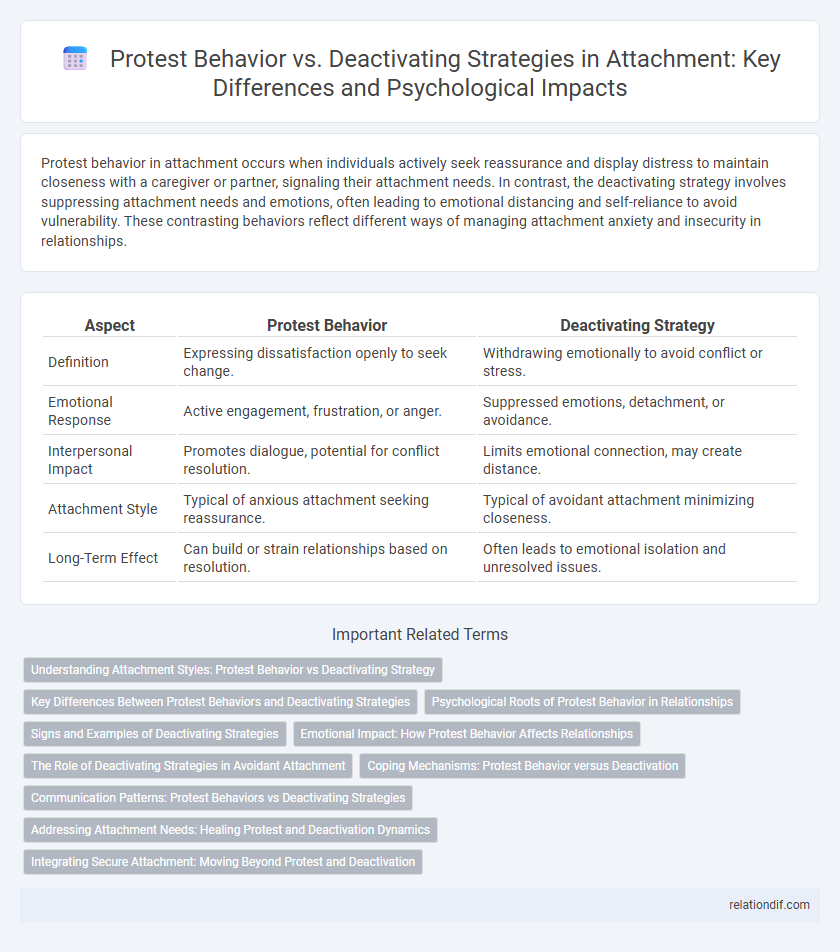Protest behavior in attachment occurs when individuals actively seek reassurance and display distress to maintain closeness with a caregiver or partner, signaling their attachment needs. In contrast, the deactivating strategy involves suppressing attachment needs and emotions, often leading to emotional distancing and self-reliance to avoid vulnerability. These contrasting behaviors reflect different ways of managing attachment anxiety and insecurity in relationships.
Table of Comparison
| Aspect | Protest Behavior | Deactivating Strategy |
|---|---|---|
| Definition | Expressing dissatisfaction openly to seek change. | Withdrawing emotionally to avoid conflict or stress. |
| Emotional Response | Active engagement, frustration, or anger. | Suppressed emotions, detachment, or avoidance. |
| Interpersonal Impact | Promotes dialogue, potential for conflict resolution. | Limits emotional connection, may create distance. |
| Attachment Style | Typical of anxious attachment seeking reassurance. | Typical of avoidant attachment minimizing closeness. |
| Long-Term Effect | Can build or strain relationships based on resolution. | Often leads to emotional isolation and unresolved issues. |
Understanding Attachment Styles: Protest Behavior vs Deactivating Strategy
Protest behavior in attachment styles manifests as intense efforts to maintain proximity and elicit a response when connection is threatened, often seen in anxious-preoccupied individuals. In contrast, the deactivating strategy is characteristic of avoidant attachment, where individuals suppress emotional needs and distance themselves to manage attachment-related distress. Understanding these divergent responses provides critical insight into how attachment patterns influence relational dynamics and coping mechanisms under stress.
Key Differences Between Protest Behaviors and Deactivating Strategies
Protest behavior in attachment theory is characterized by intense emotional distress and active efforts to regain proximity to the attachment figure, often manifesting as crying, clinging, or aggressive bids for attention. In contrast, deactivating strategies involve suppressing attachment needs, minimizing emotional expression, and avoiding closeness to cope with perceived unavailability or rejection. Key differences include the outward expression of attachment anxiety in protest behaviors versus the inward emotional suppression and self-reliance seen in deactivating strategies.
Psychological Roots of Protest Behavior in Relationships
Protest behavior in relationships often stems from attachment insecurity, where individuals react to perceived abandonment or emotional unavailability by seeking reassurance or expressing distress. This behavior contrasts with deactivating strategies, which involve emotional withdrawal and suppression of attachment needs to avoid vulnerability. Understanding these psychological roots highlights how early attachment patterns shape responses to relational threats, influencing dynamics of closeness and conflict.
Signs and Examples of Deactivating Strategies
Deactivating strategies in attachment manifest through signs such as emotional suppression, avoidance of intimacy, and reluctance to express vulnerability. Individuals employing these strategies often minimize the importance of close relationships and exhibit discomfort with dependency or closeness. Examples include dismissing others' feelings, downplaying conflict, and maintaining emotional distance to protect against perceived rejection or loss.
Emotional Impact: How Protest Behavior Affects Relationships
Protest behavior in attachment often triggers heightened emotional responses, leading to increased tension and misunderstandings within relationships. This behavior signals distress and a desire for closeness but can push partners away due to perceived neediness or volatility. Understanding these emotional impacts helps in managing attachment dynamics and fostering healthier communication patterns.
The Role of Deactivating Strategies in Avoidant Attachment
Deactivating strategies in avoidant attachment involve the suppression of attachment-related thoughts and emotions to maintain emotional distance from others. These strategies often manifest as denial of distress or minimization of attachment needs during protest behavior, reducing overt expressions of seeking support. Research highlights that deactivating strategies contribute to avoidant individuals' tendency to withdraw rather than confront relational conflicts, ultimately affecting attachment security and interpersonal dynamics.
Coping Mechanisms: Protest Behavior versus Deactivation
Protest behavior in attachment involves active efforts to gain attention and maintain closeness, often manifesting as anxiety or distress when caregivers are unavailable, reflecting a hyperactivated coping strategy. In contrast, deactivating strategies suppress attachment needs, minimizing emotional expression and distancing oneself to manage perceived rejection or unresponsive caregiving environments. These opposing coping mechanisms highlight the spectrum of attachment responses, with protest behavior amplifying attachment signals and deactivation reducing perceived vulnerability.
Communication Patterns: Protest Behaviors vs Deactivating Strategies
Protest behaviors in attachment are characterized by heightened emotional expression, persistent demands for attention, and exaggerated communication patterns aimed at eliciting responsiveness from caregivers. In contrast, deactivating strategies involve subdued communication, emotional suppression, and avoidance of intimacy to minimize perceived threats or rejection. These opposing communication patterns reflect underlying attachment dynamics, influencing relational stability and emotional regulation.
Addressing Attachment Needs: Healing Protest and Deactivation Dynamics
Addressing attachment needs requires understanding protest behavior as a signal of unmet emotional demands, prompting caregivers to provide consistent responsiveness. Deactivating strategies, characterized by emotional withdrawal, hinder attachment repair by minimizing distress and blocking communication. Therapeutic approaches that validate attachment protests while gently challenging deactivation promote healing and restore secure attachment patterns.
Integrating Secure Attachment: Moving Beyond Protest and Deactivation
Integrating secure attachment involves transitioning from protest and deactivating strategies to balanced emotional regulation and trust-building behaviors. Secure attachment fosters effective communication, emotional resilience, and coping mechanisms that mitigate defensive responses linked to protest and avoidance. This integration enhances relational stability by promoting openness and reducing anxiety and avoidance patterns in attachment dynamics.
protest behavior vs deactivating strategy Infographic

 relationdif.com
relationdif.com